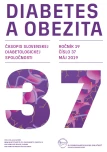Familial hypercholesterolemia and project MedPed FH
Authors:
Branislav Vohnout 1,2; Katarína Rašlová 2
Authors‘ workplace:
Ústav výživy, Fakulta ošetrovateľstva a zdravotníckych odborných štúdií, SZU v Bratislave
1; Koordinačné centrum pre familiárne hyperlipoproteinémie, SZU v Bratislave
2
Published in:
Diab Obez 2019; 19(37): 8-12
Category:
Reviews
Overview
Familial hypercholesterolemia (FH) is a common autosomal dominant genetic disorder characterised by elevated LDL cholesterol levels, accelerated atherosclerosis and premature cardiovascular disease. Important proportion of patients with FH however are not aware about the disease and there are not properly treated. The vast majority of FH patients are unrecognised and not adequately treated. Aim of the MedPed FH project is to screen and treat patients with FH and thus to prevent premature cardiovascular disease.
Received 3. 5. 2019
Accepted 20. 5. 2019
Keywords:
coronary artery disease – familial hypercholesterolemia – MedPed FH project
Sources
-
Goldstein JL, Hobbs HH, Brown MS. Familial hypercholesterolaemia. In: Scriver CR, Beaudet AL, Sly WS et al (eds). The metabolic and molecular bases of inherited disease. 7th ed. McGraw-Hill; New York 1995 : 1981–2030. ISBN 978–0079098269.
-
Müller C. Xanthomata, hypercholesterolaemia, angina pectoris. Acta Med Scand 1938; 89 : 75–84. Dostupné z DOI: <https://doi.org/10.1111/j.0954–6820.1938.tb19279.x>.
-
Nordestgaard BG, Chapman MJ, Humphries SE et al. [European Atherosclerosis Society Consensus Panel]. Familial hypercholesterolaemia is underdiagnosed and undertreated in the general population: guidance for clinicians to prevent coronary heart disease: Consensus Statement of the European Atherosclerosis Society. Eur Heart J 2013; 34(45): 3478–3490a. Dostupné z DOI: <http://dx.doi.org/10.1093/eurheartj/eht273>.
-
Brown MS, Ho YK, Goldstein JL. The low-density lipoprotein pathway in human fibroblasts: relation between cell surface receptor binding and endocytosis of low-density lipoprotein. Ann N Y Acad Sci. 1976; 275 : 244–257.
-
Gabcova-Balaziova D, Stanikova D, Vohnout B et al. Molecular-genetic aspects of familial hypercholesterolemia. Endocr Regul 2015; 49(3):164–181.
-
Gabcova D, Vohnout B, Stanikova D et al. The molecular genetic background of familial hypercholesterolemia: data from the Slovak nation-wide survey. Physiol Res 2017; 66(1): 75–84.
-
Gašparovič J, Bašistová Z, Fábryová Ľ et al. Familial Defective Apolipoprotein B-100 in Slovakia. Are Differences in Prevalence of FDB Explained by Ethnicity? Atherosclerosis 2007; 194(2): e95-e107. Dostupné z DOI: <http://dx.doi.org/10.1016/j.atherosclerosis.2006.10.015>.
-
Vohnout B, Raslova K, Gasparovic J et al. Lipid levels and their genetic regulation in patients with familial hypercholesterolemia and familial defective apolipoprotein B-100: the MEDPED Slovakia Project. Atherosclerosis Suppl 2003; 4(3 Suppl): 3–5. Dostupné z DOI: <https://doi.org/10.1016/S1567–5688(03)00023–0>.
-
Zuliani G, Arca M, Signore A et al. Characterization of a new form of inherited hypercholesterolemia: familial recessive hypercholesterolemia. Arterioscl Thromb Vasc Biol 1999; 19(3): 802–809.
-
Hovingh GK, Davidson MD, Kastelein JJ et al. Diagnosis and treatment of familial hypercholesterolaemia. Eur Heart J. 2013; 34(13): 962–971. Dostupné z DOI: <http://dx.doi.org/10.1093/eurheartj/eht015>.
-
Thompson GR. Familial hypercholesterolemia. In: Betteridge DJ, Illingworth DR, Shepherd J. Lipoproteins in health and disease. London 1999 : 675–692. ISBN 978–0340552698.
-
Piepoli M, Hoes AW, Agewall S et al. 2016 European Guidelines on cardiovascular disease prevention in clinical practice: The Sixth Joint Task Force of the European Society of Cardiology and Other Societies on Cardiovascular Disease Prevention in Clinical Practice (constituted by representatives of 10 societies and by invited experts)Developed with the special contribution of the European Association for Cardiovascular Prevention & Rehabilitation (EACPR). Eur Heart J 2016; 37(29): 2315–2381. Dostupné z DOI: <http://dx.doi.org/10.1093/eurheartj/ehw106>.
-
Catapano A, Graham I, De Backer G et al. 2016 ESC/EAS Guidelines for the Management of Dyslipidaemias: The Task Force for the Management of Dyslipidaemias of the European Society of Cardiology (ESC) and European Atherosclerosis Society (EAS) Developed with the special contribution of the European Assocciation for Cardiovascular Prevention & Rehabilitation (EACPR). Atherosclerosis 2016; 253 : 281–344. Dostupné z DOI: <.http://doi: 10.1016/j.atherosclerosis.2016.08.018>.
-
World Health Organization: Familial hypercholesterolemia – report of a second WHO Consultation. World Health Organization: Geneva, Switzerland 1999 (WHO publication No. WHO/HGN/FH/CONS/99.2). Dostupné z WWW: <http://www.who.int/iris/handle/10665/66346>.
-
Illingworth DR, Duell PB, Connor WE. Disorders of lipid metabolism. Endocrinology and Metabolism 1995 : 1315–1405.
-
Benn M, Watts GF, Tybjaerg-Hansen A et al. Familial Hypercholesterolemia in the Danish General Population: Prevalence, Coronary Artery Disease, and Cholesterol-Lowering Medication. J Clin Endocrinol Metab 2012; 97(11): 3956–3964. Dostupné z DOI: <http://dx.doi.org/10.1210/jc.2012–1563>.
-
Vohnout B, Fábryová Ľ, Klabník A et al. Treatment pattern of familial hypercholesterolemia in Slovakia: Targets, treatment and obstacles in common practice. Atherosclerosis 2018; 277 : 323–326. Dostupné z DOI: <http://dx.doi.org/10.1016/j.atherosclerosis.2018.06.857>.
-
Vrablik M, Raslová K, Vohnout B et al. Real-life LDL-C treatment goals achievement in patients with heterozygous familial hypercholesterolemia in the Czech Republic and Slovakia: Results of the PLANET registry. Atherosclerosis 2018; 277 : 355–361. Dostupné z DOI: <http://dx.doi.org/10.1016/j.atherosclerosis.20 8.08.008>.
-
Cuchel M, Bruckert E, Ginsberg HN, et al. [European Atherosclerosis Society Consensus Panel on Familial Hypercholesterolaemia]. Homozygous familial hypercholesterolaemia: new insights and guidance for clinicians to improve detection and clinical management. A position paper from the Consensus Panel on Familial Hypercholesterolaemia of the European Atherosclerosis Society. Eur Heart J 2014; 35(32): 2146–2157. Dostupné z DOI: <http://dx.doi.org/10.1093/eurheartj/ehu274>.
-
Austin MA, Hutter CM, Zimmern RL et al. Genetic causes of monogenic heterozygous familial hypercholesterolemia: a HuGE prevalence review. Am J Epidem 2004; 160(5): 407–420. Dostupné z DOI: <http://dx.doi.org/10.1093/aje/kwh236>.
-
Williams RR, Schumaker C, Barlow G et al. Documented need for more effective diagnosis and treatment of familial hypercholesterolaemia according to data from 502 heterozygotes in Utah. Am J Cardiol 1993 : 72(10): 18D–24D.
-
Vohnout B, Gabčová D, Hučková M et al. Genetic testing of familial hypercholesterolemia in a real clinical setting. Wien Klin Wochenschr 2016; 128(23–24): 916–921. Dostupné z DOI: <http://dx.doi.org/10.1007/s00508–016–1053–2>.
Labels
Diabetology ObesitologyArticle was published in
Diabetes and obesity

2019 Issue 37
Most read in this issue
- 50 rokov Slovenskej diabetologickej spoločnosti
- Hypoglycaemia in diabetes mellitus
- Odišiel MUDr. Peter Pavlov, MPH (*8. 6. 1962 – †19. 4. 2019)
- Metformin in patients with chronic kidney disease and cardiovascular disease
